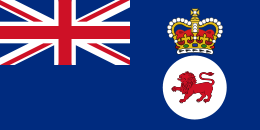Charles Gairdner
Lieutenant-General Sir Charles Henry Gairdner GBE, KCMG, KCVO, CB (20 March 1898 – 22 February 1983) was a senior British Army officer who later occupied two viceregal positions in Australia. Born in Batavia (now Jakarta) in the Dutch East Indies, he was brought up in Ireland, and educated at Repton School and the Royal Military Academy, Woolwich, in England. Having served on active duty during World War I, in which he sustained a serious wound to his right leg, Gairdner then spent time at the Staff College, Camberley, and served as commanding officer of various units during World War II. In 1951, after the conclusion of the war, he was appointed Governor of Western Australia, a position in which he served until 1963, when he assumed the role of Governor of Tasmania, a role he served in until 1968. Gairdner died in Nedlands, Western Australia, at the age of 84, and was awarded a state funeral.[1]
Early life
Gairdner was born in Batavia, Netherlands East Indies (now Jakarta, Indonesia) in 1898. Brought up in County Galway, Ireland, he was educated at Repton School in England, and the Royal Military Academy, Woolwich.[1] He married the Hon. Evelyn Constance Handcock, daughter of the 5th Lord Castlemain, in 1925.[2]
Military career
Upon graduation, Gairdner was commissioned a 2nd Lieutenant in the artillery in May 1916 and sent to the Western Front. In this campaign, he sustained a serious wound to the right leg which necessitated numerous operations throughout his life and eventual amputation in 1976.[1] After the war he transferred to cavalry. He spent two years at the Staff College, Camberley from 1933 to 1934.[2] As a lieutenant colonel, from 1937 to 1940 he was the commanding officer of the 10th Royal Hussars, before being chief of staff of the 7th Armoured Division then General Officer Commanding of the 6th and 8th Armoured Divisions.[3][4] Gairdner was General Harold Alexander's Chief of Staff during the planning stage of Operation Husky but was relieved and went on to become Prime Minister Winston Churchill's personal emissary to Douglas MacArthur in the Far East.[5] He was awarded the Medal of Freedom by the United States in London on 16 January 1947. He was appointed Companion of the Order of the Bath in 1946 and Knight Commander of the Order of St Michael and St George in 1948.[1]
Governor of Western Australia and Tasmania
Gairdner's distinguished military career was rewarded in 1951 when he was appointed Governor of Western Australia. He was governor during a number of royal visits to Perth – the earliest being that of Queen Elizabeth II in 1954.[6] His long residency in Western Australia was during a time when Perth and Western Australia were undergoing significant post-war change. He was very popular with the Western Australian public.[1]
Gairdner's tenure was relatively free of political or constitutional crisis. When Labor's loss of the October 1955 Bunbury by-election resulted in the Albert Hawke government's losing its parliamentary majority, the possibility was raised that the governor might have to exercise his reserve powers. However the parliament remained in recess until Labor won the ensuing 1956 general election.[1] The Sir Charles Gairdner Hospital in Perth was named in his honour in May 1963. Gairdner stepped down from his post on 26 June 1963. He lobbied for the position of Governor of Tasmania and on 23 September 1963 was appointed for five years.[1]
In February 1969 the Gairdners returned to Perth and settled at Peppermint Grove. Survived by his wife, Sir Charles died on 22 February 1983 at Nedlands and was cremated after a state funeral.[1]
Freemasonry
He was a freemason. During his terms as both Governor of Western Australia (1951–1963) and Governor of Tasmania (1963–1968), he was also Grand Master of the respective Grand Lodges.[7]
References
- 1 2 3 4 5 6 7 8 Boyce, P. 'Gairdner, Sir Charles Henry (1898–1983)' entry in Australian Dictionary of Biography, National Centre of Biography, Australian National University], accessed 29 February 2012.
- 1 2 Statesmen & Scholars And other fascinating Western Australians: A Tour Guide for the Karrakatta Cemetery Historical Walk Trail 1, Metropolitan Cemeteries Board (WA).
- ↑ Ammentorp, Steen. "Gairdner Sir Charles Henry, General". The Generals of WWII. Retrieved 17 November 2008.
- ↑ Lieutenant-General Sir Charles Gairdner 1951–1963, at the Constitutional Centre of Western Australia.
- ↑ Hamilton, Nigel (1983). Master of the Battlefield Monty's War Years 1942–1944. McGraw-Hill Book Company. p. 16 footnote.
- ↑ Edmonds, Jack (editor) (1979) Swan River colony : life in Western Australia since the early colonial settlement, illustrated by pictures from an exhibition mounted by West Australian Newspapers Ltd. as a contribution to celebrations for the state's 150th year Perth: West Australian Newspapers. ISBN 0-909699-20-8 – page 87 – Sir Charles with the Queen
- ↑ http://kenthenderson.com.au/m_papers03.html
| Military offices | ||
|---|---|---|
| Preceded by Herbert Lumsden |
GOC, 6th Armoured Division October 1941 – May 1942 |
Succeeded by Charles Keightley |
| Preceded by Charles Norman |
GOC, 8th Armoured Division August 1942 – January 1943 |
Succeeded by Post disbanded |
| Government offices | ||
| Preceded by Sir James Mitchell |
Governor of Western Australia 1951–1963 |
Succeeded by Sir Douglas Kendrew |
| Preceded by The Lord Rowallan |
Governor of Tasmania 1963–1968 |
Succeeded by Sir Edric Bastyan |




